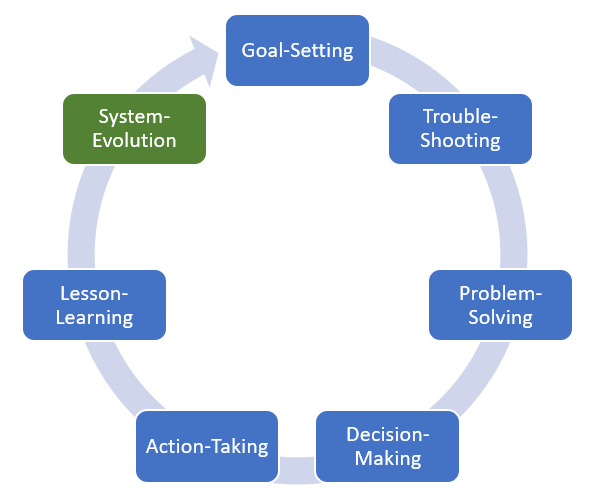
Business intelligence is a cyclical process of continuous learning and action. We modify our goals and actions depending on the results we achieve.
Goal-Setting:
Initiating the core system management pattern begins with goal-setting. Clearly defining objectives and desired outcomes provides a strategic direction for your business. Goals serve as the guiding stars, aligning your efforts and resources towards specific achievements. Understand the importance of setting SMART goals—Specific, Measurable, Achievable, Relevant, and Time-bound.
Trouble-Shooting and Root Cause Analysis:
As you progress towards your goals, challenges inevitably arise. Effective trouble-shooting involves identifying and addressing issues promptly. Root cause analysis is a crucial tool in this phase, ensuring that you don’t merely treat symptoms but delve deep to understand the underlying causes of problems. By focusing on root causes, you enhance the sustainability of your solutions.
Problem-Solving and Creative Brainstorming:
Problem-solving is an iterative process that benefits from creative brainstorming. Engage your team in generating innovative solutions, recognizing patterns that may repeat across different challenges. Foster a culture that values diverse perspectives, encouraging a rich pool of ideas to draw upon when navigating complexities.
Decision-Making and Resource Optimization:
Wise decisions are at the heart of effective system management. Every decision involves using resources to improve the value of outputs over the value of inputs—essentially maximizing Return on Investment (ROI). Embrace decision-making as a goal-oriented activity, aligning choices with the overarching objectives of your business.
Action-Taking and Practical Skills Application:
With decisions made, it’s time for action. Action-taking involves the practical application of skills in processes, tasks, projects, or programs. Executing plans with precision and efficiency moves your business closer to its goals. Recognize that action is a dynamic and integral part of the core system management pattern.
Lesson-Learning and Continuous Improvement:
Every action and decision provide valuable lessons. Embrace a culture of continuous improvement by consistently reviewing and evaluating the results achieved. Use appropriate metrics, such as Key Performance Indicators (KPIs), to measure the effectiveness of actions. Reflect on lessons learned to refine future goal-setting and decision-making.
Closing the Loop and Systemic Evolution:
The core system management pattern is cyclical. Closing the loop involves using insights from lesson-learning to inform subsequent goal-setting. This cyclical process contributes to the systemic evolution of your business, ensuring that each iteration brings increased efficiency, adaptability, and alignment with your overarching objectives.
Transition to Lifelong Systems Thinking:
As we transition to our final exploration of navigating complexity through systems thinking, keep these logical and cyclical models in mind. Recognize how the principles of systems thinking can enhance and elevate these model, providing a holistic and interconnected perspective on the dynamics of your small business.
